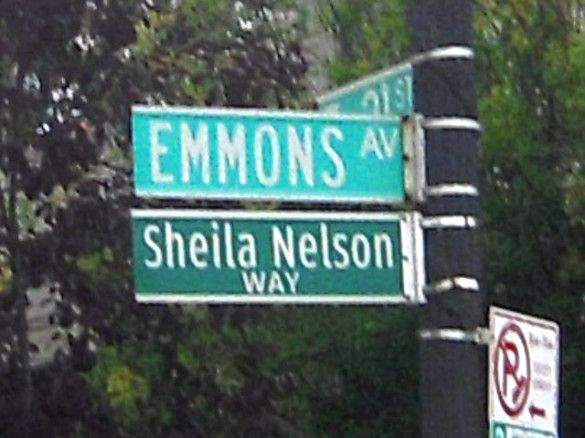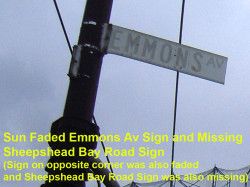Street Co-Naming Is Out Of Control

THE COMMUTE: Every time we look around, a new street is co-named. Often, we have no idea who the individual was. Okay, if it is for Police Officer X, or Firefighter Y, we can conclude they died in the line of duty. How about the others? Their names will only be known to family and friends, unless the person was famous or a local community activist. So what does honoring the vast majority of these people accomplish? Absolutely nothing. It wastes scarce city funds and causes confusion to motorists, possibly even resulting in accidents.
Debate Is Not New
A quick Google search will tell you that more than 100 city blocks and streets are co-named each year. That means that, since 9/11, when co-naming of streets accelerated, nearly 2,000 blocks have been co-named. This NY Times Editorial from 2007 condemned street co-naming. I agree and will add points of my own.
Two Forms Of Street Co-Naming
Most frequently, a sign is installed at a corner usually called “way,” “place,” “corner,” or “plaza.” A second sign is given to the family. If the naming is for a group of individuals, the other sign hangs in the office of the Council member who introduced the legislation. Sometimes a portion of an existing street is co-named and two signs are erected at each intersection. This happens usually when a renaming is requested and denied or when residents and commercial interests want to spare the expense of updating stationery, store signs and legal documents. A complete street renaming is rare.
An example of co-naming a section of a street is the Bensonhurst portion of 18th Avenue, which is also “Cristoforo Colombo Boulevard.” I can understand honoring Christopher Columbus, although we already have Columbus Avenue, Columbus Circle, Columbus Park, etc. However, what purpose does renaming part of 13th Avenue “Dyker Heights Boulevard” accomplish? Is it such a major destination that it aids travelers? Ocean Parkway is the major street used to get to the ocean. Any number of streets will take you to Dyker Heights. Very few co-names lessen confusion. One that does is the co-naming of parts of Boerum Place and Adams Street to Brooklyn Bridge Boulevard, the primary route to that bridge. (Just pray the Brooklyn Bridge is never renamed the Bloomberg Bridge.)
Confusion Caused

Some re-namings do not catch on, and sign co-naming creates confusion for drivers. First, because the signs look exactly like regular street signs, being the same size and using the same font and color. Second, when the real street sign falls off and is not replaced for years, we are just left with the co-name, as was the case at the corner of Emmons Avenue and Lena Cymbrowitz Way (i.e. Sheepshead Bay Road). Now, only faded Emmons Avenue signs remain, as you can see in the accompanying photo.
It would be easier to realize you missed your turn onto Pennsylvania Avenue if there were no sign at all rather than only a sign for the co-named street (Granville Payne Avenue). Co-names also do not appear on maps.
Real Hazards
Hazards exist on our parkways and expressways where virtually every road has two names. Imagine you are on the BQE (Gowanus) going south and exit for the Belt Parkway. The first sign you see after exiting is a large green sign naming the road “Leif Ericson Drive.” To further add to your confusion, another large sign, “POW / MIA Memorial Highway” is nearby. The entire Belt Parkway does not have a single sign stating the real name of the highway you are on, except for a westbound directional sign near JFK telling you to bear left for the Belt Parkway.
Similarly, at the Queens end of the Belt, after entering the Cross Island Parkway, the first sign you see indicates you are on the “101st Infantry Division Highway.” Again, no signs for the common name, Cross Island. Without a GPS, non-locals could easily get lost or confused, believing they made a wrong turn, resulting in a panic decision, which increases the likelihood of an accident.
The co-naming of the POW / MIA Highway is a good idea from a transportation perspective because it strings together portions of different highways across the US and gives them a single name. (However, either State or City DOT erected one of the signs on the Belt Parkway in the wrong place, just south of 65th Street.) The highway starts on Montauk Highway, continues on Sunrise Highway and the Belt Parkway, across the Verrazano Bridge into Staten Island and points west. It never veers north of the Verrazano Bridge. However, these signs need to be smaller and more frequent to be useful, as they are in Long Island. Only two large signs for the entire Belt Parkway exist, and they are either confusing or meaningless.
Do we need a Bronx Korean War Veterans Parkway in The Bronx as well as a Korean War Veterans Parkway in Staten Island? Was there a Bronx Korean War, I asked myself the first time I saw that sign. Were there more Korean War veterans from The Bronx than from the other boroughs, which necessitated a separate highway name?
An Alternative
Yes, some deserve to be honored. However, there are better ways than by co-naming streets. One way is to rename Parks Department Green Streets after deserving individuals. Placing a small plaque near each sign describing the individual’s accomplishments or why he was given this honor would be a lasting tribute, one that would not be forgotten to future generations, as well as not cause confusion to motorists.
Exceptions Should Be Made
Naming Avenue Y and Ocean Avenue “Firemen’s Corner” where the tragic Waldbaum’s fire occurred was a good idea. That sign makes a powerful statement and it does not cause confusion. However, rather than placing a similar sign in Astoria where a deadly fire occurred in 2011, resulting in the death of four or five firefighters, a separate street sign was erected for each firefighter, all at the same corner, one above the other. That makes no sense. If a pedestrian is killed at a dangerous intersection, a sign that someone was killed there would do more to encourage safe driving than a street sign with a name virtually no one will remember in future years would do.
Other Objections
Street suffixes should as much as possible describe the type of street. Avenues should not be renamed as boulevards. Would it have been less of an honor to rename Stone Avenue as Mother Gaston Avenue instead of Mother Gaston Boulevard? Why was Hopkinson Avenue renamed Thomas S. Boyland Street? Is that supposed to make drivers slow down? What would have been wrong with just Boyland Avenue, if the former name of “Hopkinson” fell out of favor? Why does Boyland need his first name and middle initial making the sign difficult to read for drivers? If you rename a corner, call it corner, not “way,” which implies a beginning and end, and not “plaza” unless you will be adding some street furniture.
Streets That Need Renaming
Meanwhile, streets that need renaming are not changed. A second Sheepshead Bay Road in Coney Island consisting of a single block street is unnecessarily confusing. We do not need a West Avenue near Ocean Parkway when we have a West Street nearby and another West Avenue in the same borough, in Greenpoint. How much confusion does that cause? Is there not a worthy person whom West Avenue in Southern Brooklyn could be renamed for?
Remember the hoopla in 2007 when Denis Hamill publicized that Austin Corbin was an anti-Semite? It was suggested to rename the street after others or simply just add a “Margaret” to make Corbin Place “Margaret Corbin Place,” after a revolutionary war fighter. The City Council was expected to approve that name change, but residents feared legal hassles or misdirected mail if street signs were changed, so it was left as is.
We need to lessen street name confusion by renaming streets that need renaming — not adding confusion and misdirecting funds for political favors to satisfy certain individuals. Adding more than a hundred new co-names to streets each year is an unnecessary waste. Is that why signs are missing for years or are not replaced until they are severely faded? Occasionally, some names are lost, like Gerald H. Chambers Square, which is now once again Corbin Place. Tell that to my GPS, which advises me to turn at that square.
The Commute is a weekly feature highlighting news and information about the city’s mass transit system and transportation infrastructure. It is written by Allan Rosen, a Manhattan Beach resident and former Director of MTA / NYC Transit Bus Planning (1981).
Disclaimer: The above is an opinion column and may not represent the thoughts or position of Sheepshead Bites. Based upon their expertise in their respective fields, our columnists are responsible for fact-checking their own work, and their submissions are edited only for length, grammar and clarity. If you would like to submit an opinion piece or become a regularly featured contributor, please e-mail nberke [at] sheepsheadbites [dot] com.




